Last year, we published a blog post about the dangers of vandalising safety signs. At the time, these sensless acts were despciably common in Britain, and we regret to announce that little seems to have changed in the intervening months. Here are two shameful stories from this week alone:
Clevedon road safety signs stolen
from the North Somerset Times
Vandals in Clevedon have removed at least seven 30mph speed limit signs, along with multiple child crossing signs, from the town's roads over the last few weeks. The chairman of a local community group stated that it would be a "big job" to check throughout the town and replace the stolen signs, which are necessary to keep motorists driving at safe speeds.
Vandals remove safety signs at Scottish reservoir
from the The Evening Times
Essential safety signs have also been stolen from the site of Balgray reservoir in Glasgow. Reports suggest that signs have been removed, thrown in the reservoir, and even set on fire; a Scottish Water spokesman pointed out that the signs "are there to help save lives" and that "the vandals' actions could put lives at risk".
It's bad enough when signs are defaced and rendered difficult to read, but people who remove them - like the vandals mentioned in the above reports - are even worse. Doing this eliminates the safety warning altogether, potentially leaving people unaware of risks to their own safety. If you see anybody vandalising or removing a safety sign in your neighbourhood, be sure to report it to the authorities - you could be saving lives by doing so!
Photo by Elliott Brown
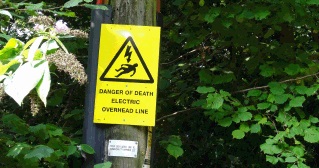
People throughout the United States of America are currently observing National Electrical Safety Month, an annual event that aims to raise awarness of electrical hazards and the potentially tragic consequences thereof. National Electrical Safety Month is organised by the Electrical Safety Foundation International (ESFI), and the initiative has been recognised by, among others, US president Barack Obama. In a message bearing his signature, the president highlights many of the hazards that accompany the use of electricity, going on to state that "it is up to all of us to protect ourselves, our loved ones, and our homes, schools, and workplaces from the dangers of electrical hazards."
While National Electrical Safety Month is an American observance, we at Label Source think that the whole world could benefit from marking the date and thinking a little harder about electrical safety. The closest thing we have in the UK seems to be Electrical Fire Safety Week (held each year in November), but this is both shorter and more specifc than the American initiative. Throughout the month of May, we'll be doing all we can to improve everybody's attitude towards electrical safety, and we'd be thrilled if everybody reading this did the same!
Here are just a few of the ways to boost electrical safety in your home and workplace:
- Leave electrical work to qualified professionals
- Abide by the manufacturer's safety instructions when using electrical appliances
- Use the appropriate safety signs and warning labels to identify electrical hazards
- Keep your electrical cables in good condition and label them to prevent accidents
From now until the end of the month, we'll be using the #ElectricalSafetyMonth hashtag on Twitter and other social networks. Follow @LabelSourceUK now to keep up with our latest posts!
Everyone has the right to a safe working environment. If you are failing to ensure the continued safety and wellbeing of your employees, you could well be liable from a legal standpoint, and - more importantly - you may be putting people's lives at risk.
So, is your workplace up to health and safety standards? Here are 3 things to check:
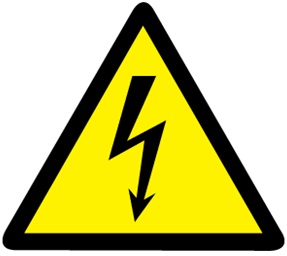
Electrical Safety
Make sure that any electrical hazards in your workplace are properly marked with the appropriate safety signs. You should also label your electrical cables to minimise the risk of an incident. Ensure that all portable electrical appliances have been PAT tested and are safe for use.
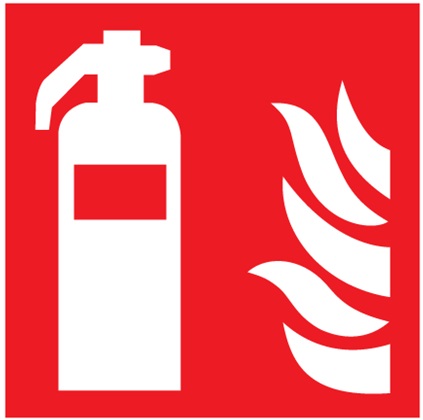
Fire Safety
Would you and your staff members be able to safely evacuate the premises in the event of a fire? Are your fire doors clearly labelled and kept shut at all times? Does your building have easily accessible emergency exits, and if so, are they clearly signposted? Will your fire equipment be easy to locate and use in an emergency situation?
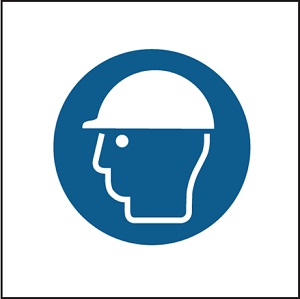
Personal Protection
Some workplaces - such as construction sites - require the use of PPE (Personal Protective Equipment). As the site owner, you must provide your workers with the necessary safety equipment (e.g. hard hats, goggles, breathing apparatus); you must also enforce the proper use of these items at all times and provide clear safety signs to inform people of any PPE requirements that apply to them.
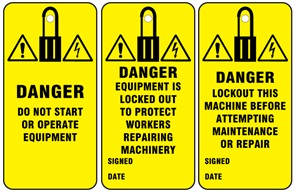
You may remember that, two weeks ago, we shared a series of upsetting stories about people who had been injured/mutilated by the machines they worked with. Well, if you want to avoid incidents like that on your premises, our lockout tags are the solution you need.
These highly-visible yellow tags can be attached to machinery and equipment to warn staff that the item in question is being serviced and may not be used until the tag has been removed by authorised personnel. This ensures that:
- Service personnel won't get trapped in moving parts when a machine starts unexpectedly
- The risk of electrocution and electric shock is kept to a minimum
- No equipment is damaged through improper use
Each of our lockout tags has a hole for easy attachment, and many of the tags give room for a signature and date, allowing authorised personnel to identify themselves when using the tags. Click here to see our full range of safety lockout products
Love it or hate it, health and safety is a hot topic here in Great Britain. New stories - some silly, some very serious - emerge every week, and it can be difficult to stay abreast of everything that's happening in the mad, mad world of H&S from one week to the next.
Fortunately, we at Label Source are more than happy to do the hard work for you. Here are 5 stories that you may have missed this week:
- Fire safety regulations made the news on Wednesday after a London resident stumbled upon a two-foot high emergency exit (pictured above). While the tiny fire escape is more or less unusable unless you're crawling on your belly, the London Evening Standard pointed out that "there are no rules about the minimum height of a fire exit" (although fire safety regulations do stipulate minimum widths). To be fair, the diminutive door is labelled with a Fire Escape - Keep Clear sign, so the proprietors have clearly put some thought into their building's fire safety.
- With economy airlines attempting to widen their profit margins by squeezing more and more passengers onto their planes, concerns have been raised about the safety of their increasingly cramped cabins. Experts have stated that a lack of space could make it difficult for passengers to escape the plane or receive medical treatment in an emergency situation.
- Downton Abbey actor Hugh Bonneville has hit out at 'health and safety culture', which he believes is plaguing modern television production. "If someone is going to look into a mirror," he said, "you need to fill out a long risk assessment form about possible damage to their irises." Bonneville then pointed out that he was exaggerating, but did express his distaste for "acronyms, targets, hurdles, barriers and red tape", which he feels are an obstacle to "getting on with the job of making programmes".
- Sadly, we've yet another gruesome story to add to our machine safety blog post: The Health and Safety Executive this week shared the horrific report of a 19-year-old from Nottinghamshire whose forearm was severed in an assembly line accident in 2013. Mark Marshall was attempting to retrieve a glove from a conveyor belt when the accident happened; the firm he was working for at the time are now in court.
- Finally, a Nestlé factory in Burton has been hit with a health and safety improvement notice after HSE inspectors found a number of issues on the premises. One of the problems was "a lack of signage pointing towards emergency escape routes". Sounds like they need to visit our Fire Safety & Emergency Access department!
Photo from Vincento/Twitter.